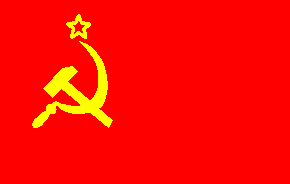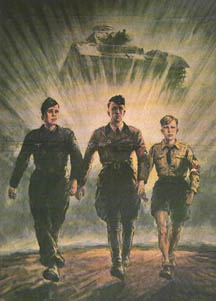News:
We have a spiffy "Welcome Area" here on reenactor.Net. It will show you how to get around and do some of the things we've found need a little explaining... to visit our Welcome Area, go here: http://www.reenactor.net/new_area/welcome_message.html
- reenactor.Net, THE Online, Worldwide Home of Living History »
- WWII »
- WWII Units
American WWII Air Corps Units
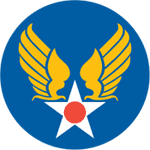
The United States Army Air Corps (USAAC) was the predecessor of the U.S. Army Air Forces (USAAF) from 1926-41, which in turn was the forerunner of today's U.S. Air Force (USAF), established in 1947. Although abolished as an organization in 1941, it existed as a branch subordinate to the USAAF from 1941-47.
What Do Air Corps Reenactors do?
There are units who reenact differing Air Corps impressions at air shows and such to show what it was like for the men in the planes. There are also ground crew reenactors, who usually show what the ground crew looked like and some of the jobs they did.
To Get your Group Listed
You do need to have a website for this listing--if you don't have one, let us know, maybe we can help.
- Click here for U.S Army Units
- Click here for U.S Army Airborne Units
- Click here for U.S Army Air Corps Units
- Click here for U.S Marine Corps Units
- Click here to visit the WW2 Women's Impressions Main page
To add your unit link, please go to our link-add page. |
Listing of WWII Soviet Units
 Welcome Tvarisch! Soviet reenacting is among the most popular and fastest growing today. It is not only a good starting impression due to it's lower costs, but is also a great way to honor this nation who sacrificed so much. The USSR lost 62 TIMES as many casualties as the United States... :-0 Is that number even conceivable? Anyway, look through the units and research them well.
Welcome Tvarisch! Soviet reenacting is among the most popular and fastest growing today. It is not only a good starting impression due to it's lower costs, but is also a great way to honor this nation who sacrificed so much. The USSR lost 62 TIMES as many casualties as the United States... :-0 Is that number even conceivable? Anyway, look through the units and research them well.
The Great Patriotic War
The term Great Patriotic War (Russian: Великая Отечественная война, Velikaya Otechestvennaya Vojna) is used in Russia and some other states of the former Soviet Union to describe the war of 1941 to 1945 between Nazi Germany and its Axis allies and the Soviet Union. The term is not generally used outside the former Soviet Union (see Eastern Front).
There is a semantic difference between this term and "World War II", as the Russian term refers only to the war between Germany and its European allies, and the Soviet Union. The war with Japan (including Operation August Storm) and the war on the Western front are not referred to by this term.
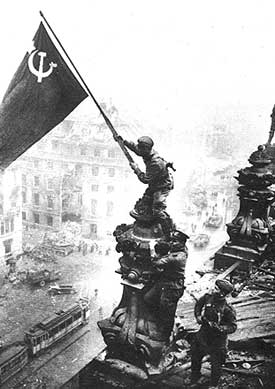 The term was coined following the German attack against the Soviet Union on June 22, 1941 and was to mobilize the population to defend the motherland. Before then, the term "Patriotic War" (Russian: Отечественная война) referred to the French invasion of Russia under Napoleon in 1812, which is now known as the Patriotic War of 1812.
The term was coined following the German attack against the Soviet Union on June 22, 1941 and was to mobilize the population to defend the motherland. Before then, the term "Patriotic War" (Russian: Отечественная война) referred to the French invasion of Russia under Napoleon in 1812, which is now known as the Patriotic War of 1812.
The term "Great Patriotic War" appeared in the Soviet newspaper Pravda soon after Adolf Hitler invaded the Soviet Union, in a long article titled "The Great Patriotic War of the Soviet People" (Russian: Великая Отечественная война cоветского народа).
In the Soviet lexicography, the war was usually presented as struggle between two ideologies, with the result of the war being the victory of Soviet socialist system over fascism.
Admin Stuff
Please report broken links to us.
You NEED to have a website for this listing, if you don't have one, let us know and we may be able to help.
Click here to visit: Women's Impressions Main page
To add your unit link, please go to our link-add page. |
If you find a problem in this time/area or would like your unit listed please feel free to e-mail the WW2T/A webmasters: Harry Coombs, Rob Haught or Tom Planinshek. |


Wilkommen to the Axis Units-Main Page of reenactor.Net!
Yes Virginia, they DO reenact WWII! WWII is one of, if not THE fastest growing aspects of the reenacting hobby. And of course, if you reenact WWII, you're gonna to need have Axis reenactors--otherwise it'd kinda be like playing "hide and seek" by yourself; you can do it, but it ain't gonna be much fun!
Die Wehrmacht (literally "defense force") was the name of the unified armed forces of Germany from 1935 to 1945. It consisted of the Wehrmacht Heer (army), the Kriegsmarine (navy) and the Luftwaffe (air force). The Waffen-SS, an initially small paramilitary section of Heinrich Himmler's Allgemeine SS that grew to nearly a million strong during World War II, was not officially part of the Wehrmacht, but subject to OKW, OKH, as well as Field Command. Thus, the Waffen-SS was, de facto, a fourth branch of the Wehrmacht.
What They're Not
And.. before you ask, No, we are NOT Nazis, in fact, Axis reenacting units usually stress their apolitical nature. If you're looking for a place to spread political ideas and rascist BS, go somewhere else -- you're not welcome here!
How to Find a Unit
So, how does it work? Well, linking from this page, you will find other pages branching off; one for each of the services in the German Military: Das Heer, Die Luftwaffe, Die Kriegsmarine and last, but not least, Die Waffen-SS plus we have separate pages for both the "Other Axis units (such as Japanese, Finnish, Romanian, Hungary, etc.)and a" "Women's Impressions page."
To add your unit link, please go to our link-add page. |
If you find a problem in this time/area or would like your unit listed please feel free to e-mail the WW2 T/A webmasters: Harry Coombs or Rob Haught. |
Alas... over the last couple of years, the Axis Units Page had grown to pages and pages long and so, we have been forced to break it down into separate pages for each branch of service. It had gotten so huge and so massive mainly because we have been adding a lot of new WWII Axis reenacting units lately. I guess all this growth is good!
Listing of Kriegsmarine Reenacting Units
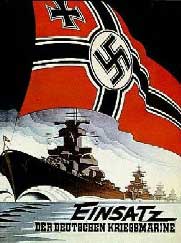 Well, it is nice to actually get some Kriegsmarine content here! Have no fear, I am sure more will be forthcoming.
Well, it is nice to actually get some Kriegsmarine content here! Have no fear, I am sure more will be forthcoming.
From WikiPedia
Die Kriegsmarine History
The German Navy (Kriegsmarine) played a major role in the Second World War as control over the commerce routes in the Atlantic was crucial for Germany, Britain and later the Soviet Union.
In the Battle of the Atlantic, the initially successful German U-boat fleet arm was eventually defeated due to Allied technological innovations like sonar, radar, and the breaking of the Enigma code.
Large surface vessels were few in number due to construction limitations by international treaties prior to 1935. The "pocket battleships" Admiral Graf Spee and Admiral Scheer were important as commerce raiders only in the opening year of the war. No aircraft carrier was operational as German leadership lost interest in the German Navy's carrier, Graf Zeppelin, which had been launched in 1938.
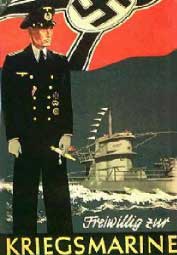 Following the loss of the Bismarck in 1941, with Allied air superiority threatening the remaining battlecruisers in French Atlantic harbours, the ships were ordered to make the Channel Dash back to German ports. Operating from fjords of Norway, which had been occupied in 1940, convoys from the USA to the Soviet port of Murmansk could be intercepted even though the Tirpitz spent most of her career as Fleet in being.
Following the loss of the Bismarck in 1941, with Allied air superiority threatening the remaining battlecruisers in French Atlantic harbours, the ships were ordered to make the Channel Dash back to German ports. Operating from fjords of Norway, which had been occupied in 1940, convoys from the USA to the Soviet port of Murmansk could be intercepted even though the Tirpitz spent most of her career as Fleet in being.
Since the appointment of Karl Doenitz as Grand Admiral of the Kriegsmarine, Germany stopped constructing battleships and cruisers in favour of U-boats.
Is there a LOT of Kriegsmarine reenacting? No, not really, but there are some groups. If it interests you, why not give it a try? This hobby is one of doing and it is still also a HOBBY meaning we do it for fun and for what interests us. If the German Navy interests you, then by all means, why not put together an impression?
Anyway, there are some groups and as we find more we'll add them here :-) Give the ones we have a look and see if they interest you.
To add your unit link, please go to our link-add page. |
If you find a problem in this time/area or would like your unit listed please feel free to e-mail the WW2 T/A webmasters: . |
Welcome to the WWII Heer Units page!
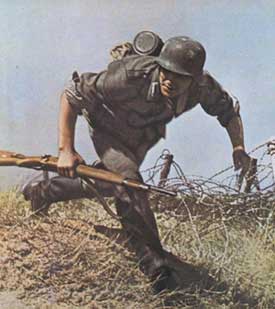 In this area, you will find listings for all the websites we can find of units portraying the German Army during the Second World War. The German Army had (has) a long and honored history (don't start, they did!) and their loyalty and honor, plus a sense of duty was a part of what made the Wehrmacht great. Loyalty to his organization, family, country and comrades is one of those things that makes the German a natural soldier and most of try and do this portrayal correctly.
In this area, you will find listings for all the websites we can find of units portraying the German Army during the Second World War. The German Army had (has) a long and honored history (don't start, they did!) and their loyalty and honor, plus a sense of duty was a part of what made the Wehrmacht great. Loyalty to his organization, family, country and comrades is one of those things that makes the German a natural soldier and most of try and do this portrayal correctly.
If you are interested in portraying a "Landser," check out one of these units listed below, they will get you going!
Das Heer
From WikiPedia:
The German Army furthered concepts pioneered during the First World War, combining ground (Heer) and Air Force (Luftwaffe) assets into combined arms teams. Coupled with traditional war fighting methods such as encirclements and the "battle of annihilation", the German military managed many lightning quick victories in the first year of the Second World War, prompting foreign journalists to create a new word for what they witnessed: Blitzkrieg.
The Heer entered the war with a minority of its formations motorized; infantry remained approximately 90% foot-borne throughout the war, and artillery primarily horse-drawn. The motorized formations received much attention in the world press in the opening years of the war, and were cited as the reason for the success of the German invasions of Poland (September 1939), Norway (April 1940), Denmark, Belgium, France and Netherlands (May 1940), Yugoslavia (April 1941) and the early campaigns in the Soviet Union (June 1941).
With the entry of the United States in December 1941, the Wehrmacht found itself engaged in campaigns against two major industrial powers. At this critical juncture, Hitler assumed personal control of the Wehrmacht high command, and his personal failings as a military commander arguably contributed to major defeats in early 1943, at Stalingrad and Tunis in North Africa.
The Germans' military strength was managed through mission-based tactics (rather than order-based tactics) and an almost proverbial discipline. In public opinion, the German Army was, and sometimes still is, seen as a high-tech army (e.g., The movie "Star Wars" features a MG42, used by the Empire's storm troopers.). These technologies were featured by propaganda, but were often only available in small numbers or late in the war, as overall supplies of raw materials and armaments became low. For example, only forty percent of all units were motorised, baggage trains often relied on horse-drawn trailers and many soldiers went by foot or used bicycles (de: Radfahrtruppen).
Max Hastings, British author, historian and ex-newspaper editor, said in a radio interview on WGN Chicago "...there's no doubt that man for man, the German army was the greatest fighting force of the second world war." This view was also explained in his book "Overlord: D-Day and the battle for Normandy". In the book World War II : An Illustrated Miscellany, Anthony Evans writes: 'The German soldier was very professional and well trained, aggressive in attack and stubborn in defence. He was always adaptable, particularly in the later years when shortages of equipment were being felt'. These views of German warriors are an attempt to evaluate their fighting abilities and not trying to excuse or justify some of the aims or actions of the Nazi regime.
Among the foreign volunteers who served in the Heer during World War II were ethnic Germans, Dutch, and Scandinavians along with people from the Baltic states and the Balkans. Russians fought in the Russian Liberation Army or as Hilfswilliger. Non-Russians from the Soviet Union formed the Ostlegionen. These units were all commanded by General Ernst August Koestring and represented about five percent of the forces under the OKH.
To add your unit link, please go to our link-add page. |







